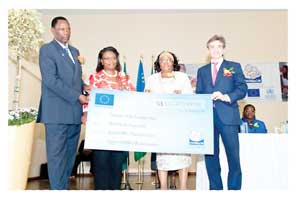
EU funds to reduce mother and child mortality

First Lady, Madam Penehupifo Pohamba (second from right) with Minister of Health and Social Services, Richard Kamwi (left), Mrs Madge Robalo, WHO Representative in Namibia, and EU Ambassador, Raúl Fuentes Milani (right), at the launch of the EU-funded programme to reduce maternal and infant mortality.
The programme for Accelerating the Reduction of Maternal and Child Mortality (PARMaCM) in Namibia, funded by the EU to the value of approximately N$100million, was launched in the Capital on Wednesday.
The programme is designed to address the challenges faced by Namibia with regard to the achievement of maternal and child health goals by 2015. The programme will be implemented in collaboration with a wide range of partners and stakeholders including UN agencies, bilateral partners and civil society organisations.
Despite excellent coverage of antenatal care services and delivery in health facilities, Namibia has made no progress in reducing maternal mortality rates since independence and although the country have improved in immunisation coverage, child health remains a challenge with high levels of malnutrition and inadequate immunisation against childhood diseases.
Officially launching the Programme for Accelerating the Reduction of Maternal and Child Mortality in Namibia, its patron and the Namibian first lady, Madam Penehupifo Pohamba said maternal and child mortality remain unacceptably high in Africa and Namibia is not an exception.
“Despite remarkable achievements in various health indicators in the country, maternal and child mortality has not shown a sign of reduction in the past two decades. The health and well-being of a mother is closely related to the survival of a child,” she said.
She said, although the programme will only be implemented in selected district, lessons learnt from those districts will be used to scale up existing programmes in other districts and regions.
“PARMaCM will contribute more specifically to improve access to and quality of emergency obstetric and neonatal cares services, support the implementation of Adolescent Friendly Health Services, improve maternal, new born and child health and nutrition programmes and services, mobilise communities for improved maternal, new-born and child health, and build capacity of health workers in selected districts and training institutions,” she said.
According to H.E Ambassador, Raúl Fuentes Milani, head of the EU delegation to Namibia, the programme will be implemented in six districts to be defined at the inception phase and will focus on rural women, children and adolescents.
“The European Union has worked closely with UN agencies in a wide range of programmes worldwide. I am sure that with the support of the WHO ,the implementation of this programme will be successful and that the objectives and expected results will be achieved,” he said.
Madge Robalo, WHO representative said the budget allocation to reproductive health is far from being adequate.
“With the newly unveiled budget and the 32% increase of the health budget, we hope that significant funding will be allocated to life-saving interventions. It is because funds have been short that we applaud the initiative of the European Union to allocate these resources to accelerate the achievement of MDG 4 and 5,” she said.
The UN resident coordinator, Musinga Bandora said the status of maternal and child health in a given country bears testimony of the level of care and attention accorded the most vulnerable segments of the population. It measures government commitment to social justice and reflects social development.
“The irony is that, this is not the case in Namibia. The government has invested heavily in the health sector with good results in terms of extensive coverage of antenatal care services and high rates of child delivery at health facilities. Yet, this has not translated into reducing maternal and child mortality in the country,” he added.













































